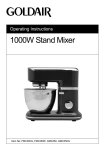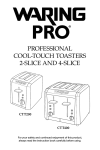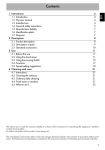Download User Manual - Stand Mixer Reviews
Transcript
Operating Your Stand Mixer General Operations 1. Place the stand mixer on suitable work surface. The surface should be sturdy, flat, smooth and clean; make sure that there is no flour or oil on the surface and away from faucets, sinks and heat sources. A clean smooth surface will provide the best footing and will limit slipping and/or “walking”. The mixer is also designed with suctions cups on the base for extra hold on the work surface to prevent slippage and provide added security. 2. Make sure the “Rotary Speed Control”(2) is set to “O” and unplugged from electrical outlet. 3. Press the “Mixer Head Release Button”(1) and lift “Mixer Head”(5) up by hand until it locks into place. 4. Select attachment you wish to use and attach to the Attachment Post. (see Assembling Your Mixer, section: To attach the dough hook, wire whisk or flat beater) 5. Lock “Bowl”(3) onto the bowl locking plate. (see Assembling Your Mixer, section: To attach the bowl) 6. Lower the “Mixer Head” by pressing the “Mixer Head Release Button” and guiding the “Mixer Head” down carefully with your hands. If the “Mixer Head” fails to lock into place, check the “Bowl” to make sure that it is properly in place. 7. Place the “Splashguard Cover” on the “Bowl”. (see Assembling Your Mixer, section: To fit and use your anti-splash cover) The cover has an integral feeding funnel. The cover may be removed to add ingredients, but the cover should be in place whenever the mixer is in operation. It is highly recommended to add ingredients through the funnel. The “Splashguard Cover” serves to prevent the escape of flour dust at the beginning of the stirring and kneading process, and also serves to prevent accidental contact with the moving “Dough Hook”. 8. Plug the mixer into an electrical outlet nearby. 9. Turn the “Rotary Speed Control” to desired speed setting. The mixer will start gradually, to avoid spattering, and build up to the selected speed. 10. To change the speed during operation, simply turn the “Speed Control” to the desired setting. 11. To turn mixer off, turn the “Rotary Speed Control” to “O”. The unit will keep turning for approximate 3 cycles to its park position before the mixer head completely stops. This is the normal operation and allows you to slowly lift the beater from the mixer. This special operational design provides for a smooth stop to the rotary action and extends the life of the appliance. Unplug the appliance from the electrical outlet. 12. To remove attachment (Dough Hook, Wire Whip or Flat Paddle), press them up as far as possible, then turn clockwise to release. Pull from the attachment post. Warning: To avoid risk of injury, be sure to switch off the stand mixer before scraping the sides of the Bowl. The Bowl is designed to mix effectively and require minimal scraping. Never attempt to scrape the sides of the Bowl while the mixer is operating. Use Dough Hook The dough hook is used for mixing bread dough of all kinds. The design of the hook is excellent for pulling sticky dough away from the side of the mixing bowl, and the cap on the hook prevents the dough from crawling up the hook and keeps it in the right mixing position. The dough hook and mixing bowl are intended to be used to knead yeast doughs and to mix heavy cookie and pastry doughs, and also when adding nuts, chocolate chips, dried fruit, hard butter or shortening, hardened brown sugar, etc. to batters. Use Wire Whisk The whisk incorporates air into liquid mixtures. The beating whisk is intended to be used for very light substances, such as cream, egg whites, sauces, batters and light pastry doughs that are thin enough to pour. As the whisk rotates faster the mixture becomes thicker and creamier. Meringues, frostings, and thick sauces are all made using this attachment. Use Flat Paddle The paddle is used for mixing thicker and heavier cookie and cake batters where the incorporation of air is not critical to the recipe. The flat paddle is also intended to be used for stirring items at low speed, such as cake mixes and light cookie doughs. Always be sure to use the dough hook for heavy cookie doughs. Removing Contents 1. 2. 3. Before beginning to remove the contents from the “Bowl”(3), make sure that the ”Rotary Speed Control“(2) is set to “O” and the power cord is unplugged. Remove the “Splashguard Cover”. Press the “Mixer Head Release Button”(1) and lift the “Mixer Head”(5) upward until it locks into place. Remove the attachment from the attachment post. The Bowl can be removed from the main unit by twist counter-clockwise. The contents may now be used as desired. Speed Control Operate Unit with Rotary Speed Control The speed of its moving components can be controlled through the use of the “Rotary speed Control”(2) at the front of the ergonomic stand. The “Rotary speed Control” has six positions: Ɣ “Pulse”: turbo speed and only use for “Flat Paddle” attachment Ɣ “O”: the off position Ɣ 4 speeds labeled - “1”, “2”, “3” and “4”: (Speed 1 is the lowest speed. The speed increases with each succeeding step up to the highest speed, speed 4.) Speed Control Guide The following speed control guide provides suggested settings for your mixer. If in doubt, always start on a lower setting and work your way up. NOTE: When working with ingredients that spatter easily, start on a lower speed and then proceed to the recommended setting. ATTACHMENT FUNCTION Dough Hook Flat Paddle Wire Whisk SETTING GUIDE Folding 1 Yeast Dough (bread dough, pizza dough) 1~2 Heavy Pastry Dough 1~2 Heavy Mixes 1~2 Mix 2~4 Cookie Dough 2~4 Blend 1~3 Combine 1~3 Cream 1~3 Meatloaf 1~3 Stir 1~3 Mash potato 1~3 Whip Cream 1~4 Egg Whites 1~4 Desserts 1~4 Frosting 1~4 Useful Tips ì ì ì ì ì Before adding ingredients to the “Bowl” during operation, turn the “Rotary Speed Control” to a lower speed. Always add the ingredients through the “Flour Feeder”. When adding flour to recipes, mix at a low speed until incorporated. Mixtures with large quantities of liquid should be mixed at lower speeds to avoid splattering. Be sure to watch liquids closely while whipping, since the powerful 450-watt motor beats quickly. When using the mixing bowl to knead or mix a recipe designed to be prepared by hand, you will find that with the Westinghouse stand mixer you can usually place all the ingredients in the mixing bowl at once. When doing this, always place the liquids in first. This will assure more thorough mixing. Special Note When your work with the attachment is completed, turn the “Rotary Speed Control” (3) to off position “O”. The mixer will keep turning for approximate 3 cycles to its park position before the mixer head completely stop. This is the normal operation and allows you to slowly lift the beater from the mixer. This special operational design provides for a smooth stop to the rotary action and extends the life of the appliance. Then unplug the unit from an electrical outlet. Care and Cleaning Always unplug the appliance after each use and before attempting to clean. Failure to do so can result in broken bones , cuts or electrical shock. 1. 2. 3. 4. 5. 6. 7. 8. Make sure the “Rotary Speed Control” is set to ‘O’ and the appliance is unplugged before cleaning. Wait until the motor head has come to a complete stop; when switched off, the motor head will continue to turn for a brief period. Please do not place hands into mixing bowl until the appliance comes to a complete stop in order to prevent possible injury. Press the “Mixer Head Release Button”(1) and lift the “Mixer Head”(5) up. Remove attachments by pressing them up as far as possible, then turn counterclockwise to release. Pull from the attachment post. The “Bowl” and attachments can be washed in warm, soapy water or in a dishwasher. Attachments are top rack dishwasher safe. Wipe down the “Mixer Head” and main unit with a damp cloth. DO NOT immerse the unit, power cord and plug in water or liquid. Do not use an abrasive or cleaning pad on the mixer base. DO NOT use household cleaners that contain bleach or pine cleaners. Do not use any type of solvent-based cleaner or metal polish on the mixer base. Do not spray cleaners directly on the mixer. Cleaners should be applied to a clean cloth before using on the mixer. If these cleaning products DO come in contact with the mixer, immediately clean with a water-dampened cloth and wipe dry. ! " # ! $ % & ! ' ( )* + ',-./ 0 $ - & # - . 0 0 # 0 0$ 0% 1 & $ + - 2$ ! 0 - 17 3 $ - 3 $ $' 4 $ -+ 0 0 - & !"' - + # - 0 # ** 0 - 5 # # # + #"6 - 4 - + # # 0 - 7 1 88 .&( 9# 0 ** - 18 ! # - ' - ! - ::0 5 1 & 2$ !; 8 #0 - $ 0 ' - 0 ! - - + $ ! - + .- 1 # #/ # + # # / << #- 8 0 <#- +!, # -71 8 .&( #- 19 - 1 0 -0 - 20


























